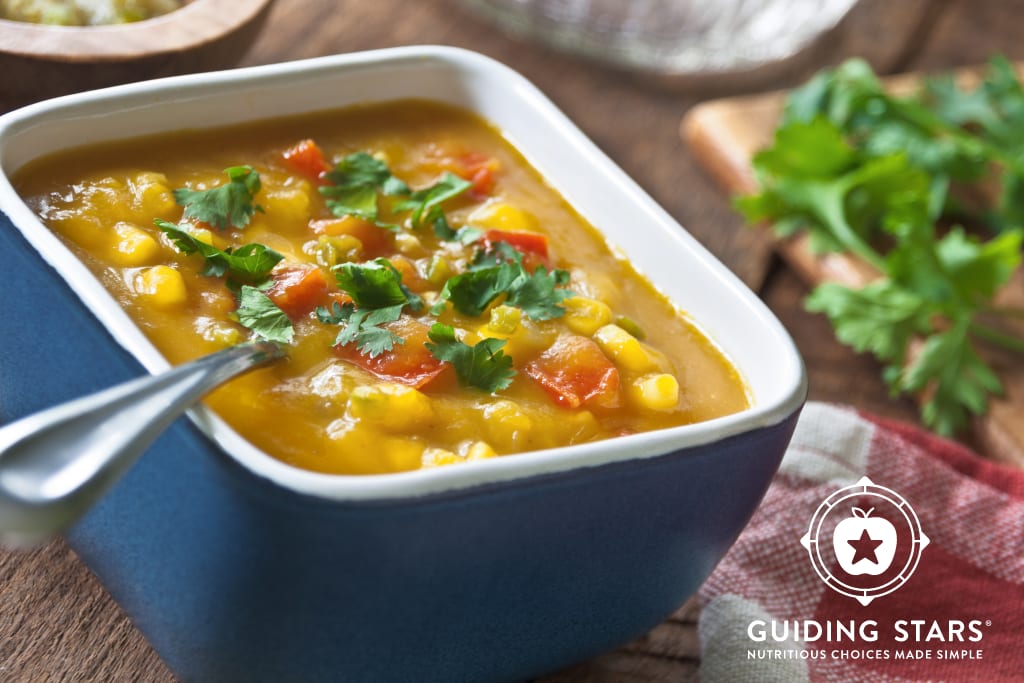
Soup season is one of my favorite cooking seasons of the year, and not only because I adore all kinds of soups. Cooking soup at home provides super benefits for those of us who are budget-conscious, busy, or simply craving some nourishing comfort food. So if you haven’t already done so this season, bust out that big ol’ soup pot, and get ready to stir up some goodness with our tips, ideas, and Guiding Stars-earning recipes.
Soup Is Budget-Friendly
A pot of soup is an easy way to stretch your grocery dollars. Many common soup ingredients are inexpensive (think beans, broth, grains, or noodles and staple veggies like onions, carrots, and celery). In-season produce is usually cheaper and widely available, so cooking soups that feature seasonal ingredients is another way to make a nourishing meal for less money. Soup is also easy on the budget because of the typical proportions of more expensive ingredients, like meat and poultry. Most soup recipes call for smaller amounts per serving than would be in a regular, plated entrée. For example, chicken and rice soup may use 2 cups of cooked chicken for the whole recipe (serving 4-6 people). But a plate of chicken and rice might call for an entire chicken thigh or small chicken breast per serving.
There are also many options for less expensive forms of ingredients. For example, bouillon cubes or paste-style broth base in a jar instead of boxes of prepared broth. Or canned or frozen vegetables instead of fresh. Finally, don’t forget that leftovers can be great soup ingredients, often easily added in toward the end of cooking.
Soup Helps Avoid Food Waste
Instead of tossing small amounts of food ingredients or leftovers, use them in a creative soup! I intentionally save vegetables that are starting to droop or are past their prime (such as celery and carrots). Then I store them in my freezer until I have enough to make a pot of stock or soup. Using up little “bits and bobs” is a challenge I love, and making soup from them is a fun technique. Some of my favorite things to keep instead of toss include:
- Small amounts of vegetables (either raw or cooked) are an easy add to soup.
- The last bits of plain yogurt or half-n-half can add a little richness to soup.
- Small portions of cooked grains and pasta—stir them in toward the end of cooking to add texture and make soup more filling.
- Any leftover canned or jarred tomato products, such as tomato sauce, marinara, salsa, or diced tomatoes practically beg to become part of the liquid used in a soup.
- Single-serve, cooked proteins that nobody felt like having for lunch. (The lonely chicken leg and the passed-over pork chop are classics at my house.)
Soup-Making Saves Time
Soup is the ultimate meal-prep food. It often tastes better on the second (or third) day, and it’s easy to make a large quantity with no extra work at all. Most soups freeze easily too, so you can have it at the ready for those days when you’re scrambling to get dinner on the table. Do keep in mind that freezing isn’t kind to creamy, dairy-based soups or soups with pasta or potatoes. (Milk products separate, and pasta absorbs a lot of the liquid and gets mushy.) You can always freeze some of the soup before adding these ingredients, and then add them when you reheat it.
Soup Is Easy to Make
Anyone can make soup, even young children (with some supervision of course). Soup is one of the easiest things to cook, and very forgiving (meaning if you mess up a little bit, it probably won’t matter). If you have a little soup-cooking experience or are willing to experiment, you don’t even need a recipe. However, if you’re a total novice, a good, basic recipe can be very helpful. It will teach you how to layer the ingredients for best flavor and ensure they’re all cooked to proper doneness. This recipe for Minestrone Soup is a good one to start with.
Soup-Making Doesn’t Require Much Equipment
If you’ve got a pot or a large saucepan, you can make soup. A slow cooker can also be very handy for soup-making—you can’t beat it for convenience. If you have one, haul it out of the closet and dust it off. Then just quickly combine the ingredients in the morning and let the soup cook throughout the day. Soup recipes written specifically for slow cookers (like this Lentil Chili) are the best choice if you go this route. Stovetop soup recipes will often need adjustment if you want to modify them for the slow cooker (you’ll usually layer ingredients differently and use less liquid).
Soup Is Easily Tailored for Your Health Needs
If you need to follow a special diet, have food allergies, or simply want to keep a lid on things like added salt, soup is easy to modify. Vegetarian or vegan soup recipes are easy to find online. And careful selection of ingredients like broth, condiments, and canned products can make it easy to keep sodium levels low. (Be sure to choose low- or reduced-sodium or no-added-salt options.) Don’t forget that ingredients that earn Guiding Stars are lower in sodium than ingredients that don’t have star ratings.
Some soups have a little sweetness added, but if you’re watching added sugar, you can skip it. Want more fiber? Bump up the veggies or add a whole grain to the soup. Want more protein? Add some pulses or legumes, or increase the protein component that it already includes. Soup is one of those dishes that’s easy to make your way, so adjust it to your taste and health requirements.